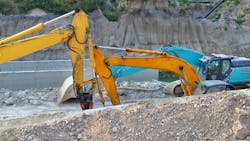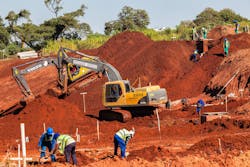Hydraulic excavators can accomplish multiple tasks on job sites, but their versatility can trick operators into thinking that they can do more than they’re built to do. As one of the most familiar machines in the industry, excavators can also give even experienced operators a false sense of security.
Ground conditions can shift or collapse, grades can cause machines to topple, and every inch of the 360 degrees surrounding an excavator holds a potential impact point or hazard as it swings or travels. An operator lapse of even a second can damage the machine or surrounding structures, or can take the life of someone nearby.
What is the safety procedure for an excavator?
Manufacturer product and safety experts recommend that excavator operators survey work areas and ground conditions before beginning work with the machine. Look for uneven areas or soft ground conditions, as a stable foundation will minimize the risk of tipping.
“Inspect the job site for any new obstacles from the day before,” says Tyler Anderson, senior product safety and compliance engineer for Bobcat. “Doing this inspection during the daily equipment walkaround is a great way to make sure all aspects of the job site are considered.”
The site inspection should also identify potential hazards, some of which can be cleared away before operations begin.
“A safe working environment should be clear of any unnecessary debris that can interfere with the excavator's movements,” says Jacob Sherman, product and dealer marketing manager for Develon North America. “When the job site is clutter-free, the operator can clearly see the area and work more efficiently, as well as navigate or move the machine for increased productivity.”
Anderson says, “Operating an excavator…can pose a safety risk if the operator…doesn’t take a proactive and mindful approach to job site safety. Continuous awareness of the surrounding environment is one aspect….”
On demolition projects, special consideration should be made to avoid tipping over the machine as it crawls around the site, as a tip over can cause injury or death. A tipping machine can causeMake sure the area is stable before moving or lifting debris.
How to avoid tipping an excavator
Hitachi’s operator’s manual addresses excavator tipping, a danger always present when operating on a grade. Operators should not attempt to jump clear of a tipping machine, as serious or fatal crushing injuries can result. The machine will tip over faster than the operator can jump free, according to Hitachi.
To avoid tipping:
- Be extra careful before operating on a grade.
- Prepare the machine operating area flat.
- Keep the bucket low to the ground and close to the machine.
- Reduce operating speeds to avoid tipping or slipping.
- Avoid changing direction when traveling on grades.
- Never attempt to travel across a grade steeper than 15 degrees if crossing the grade is unavoidable.
- Reduce swing speed as necessary when swinging loads.
- Be careful when working on frozen ground. Temperature increases will cause the ground to become soft and make ground travel unstable.
The cab is the work area for an operator. Although a typical office can still function in clutter, messy cabs are dangerous. Operators not only can trip on a dirty floor when entering or entering a cab, but clutter can also interfere with foot operations or cause distractions. Clean boots, especially the soles, before climbing into the cab. Keep windows clean and free from fogging up.
The operator’s manual from Hitachi Construction Machinery Americas advises that operators avoid wearing loose clothing, jewelry, or other items that can catch on control levers or other parts of the machine.
Distractions can take away operator attentiveness, and even the shortest moment unfocused on the task at hand can lead to an accident. As cabs become more sound-insulated and feature Bluetooth and other amenities, listening to the radio or using music headphones can be distracting. Mobile phones pose their own set of distractions to avoid.
How to avoid trench accidents
Trenches and people are two common hazards involved in excavator mishaps, both of which can result in fatalities. Operators should stay a safe distance from trench edges to avoid collapsing the walls and possibly trapping those in it. Best practice, according to Sherman, is to position the machine on a stable, level surface and avoid putting stress on the soil or edge of the trench.
Knowing where people are working or standing is crucial before ever moving or swinging the excavator. Blinds spots exist around the boom, arm, and bucket, as well as behind and around the machine. Cameras, mirrors, or a spotter can help an operator know when it is safe to move the machine. Riders should never be allowed on the machine while it is moving, either.
As operators move the excavator, they must confirm that the direction of travel corresponds to the levers and pedals. The Hitachi manual says to determine the position of the undercarriage, pointing out that if travel motors are in front of the cab, the machine will move in reverse when levers or pedals are operated to the front.
Obstructions also pose risk not only to the operator, but also to nearby people. Moving over fragments of rocks or metal pieces may scatter the material, which may hit those standing around the travel path. Operating on a slope can cause the machine to slip or overturn, injuring not only the operator, but also anyone near enough to be struck by the boom or other parts of the machine.
When climbing up or down a slope, keep the bucket facing the direction of travel, slightly above the ground. If the machine starts to skid or become unstable, lower the bucket to the ground and stop traveling.
Backing up over a person or hitting them with a swinging upper structure or stick can cause death or serious injury. Check the surrounding area before reversing or swinging, use the horn to warn others before moving, and be alert for anybody moving into the work area.
About the Author
Rod Sutton
Sutton has served as the editorial lead of Construction Equipment magazine and ConstructionEquipment.com since 2001.
Our mission is to help managers of heavy equipment and trucks to improve their performance in acquiring and managing their fleets. One way we do that is with our Executive Institute, where experts share information and ideas that will enable equipment managers to accurately manage equipment costs so that they can deliver the optimum financial benefits to their organizations.
We also have a laser focus on product development, performance, and technology; as well as equipment acquisition, disposal, and maintenance. Our exclusive Field Tests take earthmoving equipment and truck into the field for professional evaluations.
Check out our free newsletters to see the latest content.
You can find Sutton on LinkedIn.


